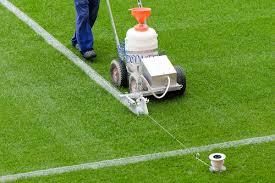Click here for the 'Seeds of Eaden' seed shop
1. All Year Round Maintenance Operations
Grass Cutting Operations - General
Cut all football pitches with a cylinder cut mowing machine fitted with
turf tyres and with no less than five blades per cutting reel. Cut the
sward allowing all clippings to fly and ensure that excessive arisings are
evenly distributed over the site.
Throughout the playing season (August to May) maintain the height of
grass between minimum 40mm and maximum 50mm. During the post season period
(May-Aug) maintain the height of grass between a minimum height of 25mm and a
maximum height of 40mm.
Mark out all pitches in accordance with Football Association Rules and
Regulations.
Remove all deleterious materials from the pitch area prior to the commencement
of the match. Ensure that all potholes and other such holes are filled in prior
to commencement of the match.
Ensure that all goalposts are erect and straight, and that they are firm
in the sockets and upright. Also ensure that all net hooks are in place.
Aerate the Pitch
Aerate the pitch on one occasion per month from September to April at
equally spaced intervals, using tractor mounted equipment equipped with turf
tyres. Aerate using slit tines penetrating to a minimum depth of 100mm.
Do carry out aeration in periods of inclement weather to avoid damaging
the pitch.
Harrow the Pitch
When required chain harrow the whole pitch. making two passes in
different directions along the length of the pitch, ensuring no overlapping.
Use a tractor fitted with turf tyres and make sure that ground conditions are
suitable for such vehicles.
2. Post Season Operations
The post season shall run from May till August. Carry out and
complete all post season renovation operations by the end of May.
Remove all goalposts from the pitches and cap off the goal sockets.
Cultivate all areas of wear, these will normally be in the goal and penalty
areas and the centre of the pitch. Cultivate to a depth of minimum 50mm.
Following cultivation operations level and produce a tilth ready for
overseeding. Overseed all cultivated areas with a seed mixture of 80% perennial
Ryegrass and 20% Browntop Bert or Smooth Stalked Meadow Grass. Irrigate areas
to a minimum depth of 50mm per occasion, to ensure the sufficient growth levels
are achieved.
Carry out contravation operations on all areas of the pitch not
renovated above by the use of a tractor mounted contravator. In periods
of dry weather suspend the contravating operation until September,
substituting during May by overseeding all areas at rate of 30 grams per square
metre. Erect and maintain a fence or similar barrier surrounding these
areas.
The renovations should be subject to standards and rate of growth as follows:
|
Time
|
Growth
(Establishment Minimum)
|
Weed Content
(Maximum)
|
|
End of June
|
40%
|
5%
|
|
End of July
|
75%
|
2%
|
|
Wk 3 of August
|
98%
|
0%
|
Supply and Apply Selective Herbicide
Every two years supply and apply a selective herbicide to the whole pitch to
kill turf weeds such as daisy and clover. This operation should be
undertaken in May or June.
Supply and Apply Spring/Summer Fertiliser
Apply during suitable weather conditions a spring/summer fertiliser at
an N:P:K OF 15:5:5. Apply the fertiliser while the grass is actively
still growing and cover the whole grass area, ensuring that there are no gaps
between the strips and no overlaps occur.
3. Pre-Season Operations
During August paint the goalposts. Rub down and apply white paint to all
goal sets. During this operation inspect all posts for damage.
 Set Out Pitch
Set Out Pitch
During August set out all pitches, ensuring that all pitches are set out
in accordance with Football Association Regulations. At the commencement
of the setting out operations, decide where pitches need to be relocated to
prevent wear. Goal sockets should be installed according to the
manufacturer’s instructions.
Erect Goal Sets
Erect all goal sets during August, ensuring they are firmly inserted in
the sockets and upright with no leans, and that crossbars and uprights are
level.
4. Surface Drainage
Sanding Goal Mouths
Where drainage is a problem apply a lime-free sand evenly across the
require areas to goal mouths and other areas of the pitch.
Vertidrain Pitches
It may be necessary to carry out vertidraining of the whole pitch or the
goal mouths and centre circles or other areas of compaction. Ensure that any
vertidraining operation is carried out in suitable weather conditions. Ensure a
minimum depth of penetration of 50cm and a size of tine of 20mm. When
using hollow tines, ensure that all cores are removed from site to the
designated location for disposal at the end of the work period.
For related articles click onto:












